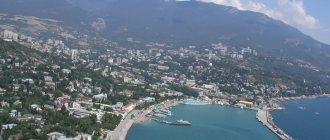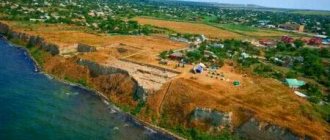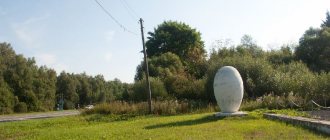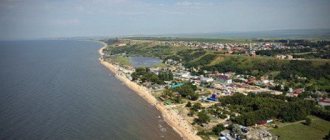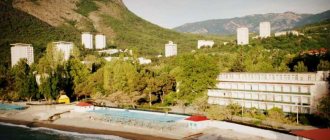The city of Zheleznovodsk is a small, picturesque city in the Stavropol Territory. This is the northernmost, greenest resort town of the Caucasian Mineral Waters, located in the valley of the Dzhemuk and Kuchuk rivers on the southern slope of Mount Zheleznaya, 5 km from the Beshtau railway station, 19 km north of Pyatigorsk, 21 km from the Mineralnye Vody station. The population of the city is 23.8 thousand people, excluding the village of Inozemtsevo and its suburbs (2008). The total number is 52.7 thousand people. Area - 93 sq. km.
Where is Zheleznovodsk located?
The city of Zheleznovodsk is located in the Caucasian Mineral Waters region. Along with neighboring Pyatigorsk, Essentuki and Kislovodsk, it is one of the 4 resorts of the KMS. However, people who do not drink mineral water often ask, “Where is Zheleznovodsk?” So, the city of Zheleznovodsk is the Stavropol Territory. The city and region is located in the southwest of Russia. Time in Zheleznovodsk is Moscow time.
From here, in a couple of hours you can get to Kabardino-Balkaria, Karachay-Cherkessia and North Ossetia. It will take a little longer to travel to Ingushetia, Chechnya, Adygea, Dagestan and the resorts of the Krasnodar Territory. You can find Zheleznovodsk on the map below.
- You can book a room in a sanatorium with treatment on the websites sanatoriums.com and sanatory.ru
- How to get to Zheleznovodsk
- Where to buy a tour to Zheleznovodsk
Home\Stavropol Territory\Administrative-territorial division\City and municipal districts
Resort city Zheleznovodsk, Stavropol Territory
Status: municipality
Official website: www.adm-zheleznovodsk.ru
City area: 93.13 km
Population: 52.41 thousand people.
Address: City Administration 357400, Zheleznovodsk, st. Kalinina, 2.
Phone: (87932) 3-28-24, 4-23-14, fax: (87932) 4-18-93
e-mail: admzhv @ mail . ru
Official website: www.adm-zheleznovodsk.ru
Head of the resort city of Zheleznovodsk, Stavropol Territory
BAKULIN Evgeniy Evgenievich
The term of office is 5 years. Election date: 12/14/2021
Chairman of the Duma of the resort city of Zheleznovodsk, Stavropol Territory
RUDAKOV Alexander Anatolievich
The term of office is 5 years. Election date: 10/08/2021
Deputies:
number of deputies - 20, of which 20 are active
The term of office is 5 years. Date of election: 09/29/2016.
address: 357400, Zheleznovodsk, st. Kalinina, 2;
telephone: 8 (87932) 3-21-55, fax: 8 (87932) 3-30-05.
BRIEF HISTORICAL BACKGROUND
Zheleznovodsk is the northernmost, smallest and most picturesque resort of the Caucasian Mineral Waters. The population of the city is more than 50 thousand people. At the same time, Zheleznovodsk is the largest city in Caucasian Mineralnye Vody in terms of territory (93 hectares). The administrative boundaries of Zheleznovodsk include: the village of Inozemtsevo, the Beshtau microdistrict, residential areas - Kapelnitsa and Rosa Luxemburg.
On the one hand, it is a modern resort with developed infrastructure, on the other hand, it is a small and cozy town, glorified in the works of our great compatriots. “Little Switzerland” is also the name of the city, which is located in a picturesque valley formed by the Beshtau and Zheleznaya mountains in a natural forest at an altitude of 630-650 meters above sea level. Zheleznovodsk, in its meteorological conditions, approaches the climate of the middle Alps, and is quite favorable for treatment, both in summer and winter.
Beautiful deciduous forests have a very beneficial effect on the climate; the air is saturated with oxygen and phytoncides, which have a beneficial effect on the human body. About 1,350 plant species grow here, 125 of which are medicinal.
Of the 9,313 hectares of the total area of the city, 4,247 hectares are occupied by forests.
The Zheleznovodsk valley, overgrown with dense broad-leaved forest, resembles the dark green surface of the sea with dome-shaped and steep islands. The famous geologist V. Abikh, back in the mid-19th century, called this area a “rocky archipelago.” The mountains surrounding the valley are very similar to the islands - laccoliths (failed volcanoes) - Zheleznaya, Medovaya, Tupay, Ostraya, Razvalka, Beshtau.
The two components of Zheleznovodsk that brought it worldwide fame are its natural resources and the great people who visited the resort.
Zheleznovodsk owes its existence and recognition as a world resort to the main wealth exuding from the depths of Mount Zheleznaya - mineral waters and, first of all, Smirnovskaya and Slavyanovskaya.
In terms of the chemical composition, the waters of almost all Zheleznovodsk springs are of the same type and are classified as carbonic hydrocarbonate-sulfate-sodium-calcium.
A remarkable feature of the waters of Zheleznovodsk mineral springs is their temperature. High temperatures are absolutely not typical for calcium waters. Zheleznovodsk is a happy exception to the rule. These are the only high-temperature calcium waters in our country and Europe.
Currently, the flow rate of Zheleznovodsk springs reaches 2 million liters per day. Mineral waters from most springs in Zheleznovodsk are bottled in all regions of Russia, exported to the CIS countries and
Baltic states, Israel, Germany and the USA.
The first general acquaintance with Zheleznovodsk always amazes visitors with the abundance of healing capabilities of the resort. Many diseases of the stomach, intestines, liver and kidneys, biliary tract, the consequences of inflammatory processes in the abdominal cavity, diseases related to metabolism, urological and gynecological diseases are treated here.
Since the very inception of the resort, Zheleznovodsk has been a generally recognized children's resort, which occupies a leading position in the Caucasian Mineral Waters. In the anniversary book for the 100th anniversary of the Caucasian Mineral Waters it is written: “In Russia it is difficult to find a climatic point that would be more suitable for the goals of creating a children’s resort than Zheleznovodsk.” It is recommended to bring weakened children to Zheleznovodsk. Beautiful mountain air, mineral water, rich vegetation, an abundance of balneological remedies - all this, together with active games in the air, leads to the rapid restoration of the child’s body.
The area where the city is located has been inhabited by people since ancient times. Dozens of archaeological monuments have been discovered here: burial mounds of the Bronze Age, in particular the Maikop culture of the third millennium BC, burial grounds of the Koban culture, early Iron Age, Scythian and Sarmatian tribes, the Alan state, the remains of settlements and fortifications.
Since the 7th century, the northern branch of the Great Silk Road, connecting Europe and Asia, passed here. Caravans loaded with Chinese silk made a stop at Mount Razvalka before the last transition to the Black Sea ports of Abkhazia.
However, the history of Zheleznovodsk goes back only two centuries. But this not very long history is decorated with the best names of representatives of Russian science and culture. It is rare that any of the wonderful Russian people who have visited here have not added anything to the glory of the resort.
Academician P.S. Pallas was the first to report the existence of a healing spring behind Mount Beshtau in 1793. The hot spring under the Iron Mountain was discovered in 1810 by the famous ophthalmologist F.P. Haaz.
Following F.P. Haaz, professor of the Medical and Surgical Academy A.P. Nelyubin in 1823 discovered 7 more springs at the foot of Mount Zheleznaya.
Nowadays, 2 springs (hot and cold) at Mount Zheleznaya bear the names of the Nelyubinskys.
Initially, the Zheleznovodsk resort occupied a small area. On the site are the Group Office building, the local history museum, the building of the former New Baths and the resort laboratory. After the construction of a group office here, this site began to be called Kontorskaya.
In 1825, on the southeastern slope of Mount Zheleznaya, according to the design of the architects Bernardazzi brothers, a park was founded - another attraction of the resort city of Zheleznovodsk.
The medical park occupies an area of 57 hectares and is part of a forest park, which is laid out on the basis of a natural forest (the only one of the parks on the Caucasian Mineral Waters), has no boundaries and imperceptibly passes into the natural Beshtaugorsky forest, which occupies an area of more than 12 thousand hectares. A wide clearing was cut down and paths were laid. The central alley of the park ran past the main springs, enclosed in elegant drinking pavilions and galleries.
The park includes two elegant drinking pavilions and galleries. The park was divided into two sections - Lower and Upper. The upper park is laid out in an oak grove and consists mainly of oak and ash interspersed with elm, field maple, hawthorn and other species. The lower park is almost entirely covered by hornbeam and beech forest.
The Zheleznovodsk Forest Park was of great importance in the development of the Caucasian Mineral Waters parks. Planting material was exported from this park to other resort cities.
For many decades, Zheleznovodsk Landscape Park was the only center of culture for both resort visitors and local residents.
Currently, the park contains pump rooms of famous mineral springs: Slavyanovsky and Smirnovsky, architectural and historical monuments: Palace of the Emir of Bukhara, Lermontovsky Square, Sundial “Zodiac Signs”, Pushkin Gallery, Pushkinsky Square, Cascade Staircase - the best panoramic point in Zheleznovodsk and a favorite walking place for locals and vacationers, and many others. other.
The resort park has been repeatedly recognized as the winner of all-Russian and regional competitions for the title “Best Resort Park of the Year”.
Real fame for the Zheleznovodsk resort came at the end of the 19th and beginning of the 20th centuries, which brought significant changes to the further development of the resort, and Zheleznovodsk began to be compared with fashionable French resorts.
The Zheleznovodsk resort is distinguished by the fact that one of its territorial features is the separation of residential, resort and industrial zones. The complete absence of city noise and bustle, from which the sick are so eager to escape, the picturesque location, the favorable climate - all this contributed to its prosperity.
In the mid-19th century, a feature of iron waters was their low flow rate and lack of stability. In the 20th century, the first regime observations of the healing waters, their chemical composition, gas saturation and flow rate began at the resort. Such observations continue to this day.
At the end of the 19th century and the beginning of the 20th, the city took on a new look. A magnificent building of the Ostrov Baths in the oriental style is being built, where mud therapy will subsequently become widely used. The Beshtau-Zheleznovodsk railway line is being built, electricity is supplied from the White Coal hydroelectric power station, fresh water is supplied to houses through a water supply system, new city buildings are being erected, private sanatoriums and clinics are being built.
At the beginning of the 20th century, in 1908, the first workshop for manual bottling of mineral water was created in Zheleznovodsk. The first thousand bottles were poured into it. Currently, 8 enterprises carry out bottling of mineral water.
Zheleznovodsk received its intensive development after 1920, when Soviet power was established and the city was recognized as a medical institution of national importance. All private dachas in the city were nationalized, and mansions and resort establishments were transferred to the resort management. In the summer, 8 sanatoriums operated, along with which new ones were built. New spring pump rooms are also appearing.
In 1938, the resort became year-round. By 1940, there were already 16 sanatoriums operating in the city.
In the 50s, a city lake was created. In the 70s, a new mud bath building was built. At the same time, comfortable sanatoriums were built, equipped with all the necessary medical equipment for successful treatment according to the resort profile.
In 1990, the city of Zheleznovodsk, Stavropol Territory, was recognized as historical and included in the List of Historical Populated Places of the RSFSR.
In 1992, Zheleznovodsk became part of the specially protected ecological resort zone of the Caucasian Mineral Waters.
In 1997, the city received the prestigious international Golden Mercury award in Italy for achievements in the field of architecture and urban planning.
In 2000, the European Association of Resort Cities recognized Zheleznovodsk as one of the best balneological health resorts in terms of natural factors.
For a unique project for the reconstruction of the oldest part of the city, Zheleznovodsk was awarded a gold medal at the International Exhibition in Leipzig.
In 2002, Zheleznovodsk took first place in the All-Russian competition for the title “The Most Comfortable City in Russia.”
In 2006, the resort town of Zheleznovodsk was recognized as a resort of federal significance.
On September 25, 2010, the resort town of Zheleznovodsk turned 200 years old.
On November 29, 2010, by decision of the City Duma, another official symbol of Zheleznovodsk was approved - the anthem.
In 2022, restoration work at the Pushkin Gallery was completed. At the historical site, hydro-steam insulation of the roof was installed, the wall coverings of gutters and overhangs were changed, as well as the installation of a roof on a solid wooden flooring. In addition, a new sheathing of beams was installed on the roof of the Gallery and the metal surfaces were painted.
On July 7, 2022, the Swifts aerobatic team performed aerobatic maneuvers such as the Nesterov Loop, synchronized Barrels, Bell and Fountain in the skies over the resort city of Zheleznovodsk.
In September 2022, the resort city of Zheleznovodsk gathered the best balloonists of the country, becoming the center of the XX International Festival on the Caucasian Mineral Waters “Pearl of Russia - 2018”.
On November 26, 2022, in Zheleznovodsk, after reconstruction, the Lermontov health path was inaugurated, which became the first facility in the country equipped exclusively with resort tax funds.
A gift for the New Year 2022 for residents and guests of the Zheleznovodsk resort was the opening, after a large-scale reconstruction, of the city palace of culture, which became the largest in the territory of the Caucasian Mineralnye Vody. New equipment makes it possible to hold high-profile festivals and concerts, stage modern theater productions, and opens up many opportunities for all types of creativity.
Settlements included in the urban district
| № | Name | Number population | Number voters |
| 1 | Resort city Zheleznovodsk, Stavropol Territory | 24 900 | 16 218 |
| 2 | Inozemtsevo village | 27 500 | 20 313 |
Weather in Zheleznovodsk. When is the best time to relax?
People go to Zheleznovodsk on vacation all year round. As with most Russian resorts, the best time to travel here is summer . Summer in the city is warm, sometimes hot. However, June can be cool, varying from year to year. In addition, at the beginning of summer, cyclones often bring rain. In August, the sky clears up and you can even see the Caucasus Range if you climb higher.
The heat that comes to the city in the second half of summer is easily tolerated. In the resort park, in the shade of trees, the sun practically does not burn, but you can always go down to the resort lake to sunbathe and even swim. Of course, the best time for a holiday in Zheleznovodsk is July-August, but you need to take into account that during this period the prices are the highest.
Prices in sanatoriums are tied to the season. Along with the summer months, the price maximum can be observed during the May holidays and the New Year. But in the fall , on the contrary, prices begin to decline. In September it is still summer here, even with less rain on average than in August. Only during the day it is no longer hot, and the nights are cool. Children need to go to school, so the number of vacationers and prices begin to fall. October cannot be called rainy either, the days are still warm, almost Indian summer, but the nights are already cold. This is the best month for a budget trip, when you can have an inexpensive vacation. In November, daytime temperatures can already drop to zero. Rain is rare, but very cold, and the sky is often overcast. November and February are considered low season.
However, in winter it is not much better here. Snow does not fall at the resort every year and melts quickly. There is ice underfoot and freezing rains are frequent. The winters themselves are mild, and there are practically no serious frosts. But in February there are winds. Nevertheless, during the New Year holidays many vacationers come here. The nature here in winter can be fabulously beautiful. At this time, vacation prices are the lowest here, but the climatic conditions are not the best.
Photo: Oleg Mar / commons.wikimedia.org
Spring in Zheleznovodsk begins in March. Literally every day it becomes warmer. In March-April the first flowers appear and the trees turn green. There are still frosts at night, and during the day it can be already summer-like warmth, but it is not constant and quickly gives way to coolness. There are frequent fogs in the mornings, but rains only come in May. May is generally the rainiest month here. However, May can already be considered the summer months, with a slight stretch. After the May holidays, you will still be able to go on an inexpensive vacation for some time, and then the high summer season will come.
Below you can see monthly ticket prices to Mineralnye Vody.
FAQ
What to see in Zheleznovodsk on your own? Church of the Holy Equal-to-the-Apostles Grand Duchess Olga of Russia, Railway Station, Eagle Sculpture, Ostrovsky Baths, Slavyanovsky Spring, Intercession Church.
can you go with children in Zheleznovodsk Resort Lake, Stagecoach Post Station Museum, Terraincourt in Zheleznovodsk, Zheleznovodsk City Museum of Local Lore, Resort Park and Cascade Staircase.
The main attractions of Zheleznovodsk? Pushkin Gallery, Smirnovsky Spring, Resort Lake, Egg of Wishes, Resort Park and Cascade Staircase.
Where to eat in Zheleznovodsk
Most of those who come to Zheleznovodsk for rest and treatment are still accommodated in sanatoriums. The trip almost always includes 3 meals a day on a full board basis. The food is usually dietary and in most health resorts it is very meager, but you will not go hungry. If the sanatorium food completely tires you out, you can always find somewhere tasty to eat. In Zheleznovodsk, like in any other self-respecting resort, there are cafes, restaurants and even a pizzeria.
Finding them will not be difficult both in the resort area and in the residential sector of the city. It is worth noting that most of them start working around lunchtime, so it is unlikely that you will be able to have breakfast in a good cafe.
Among others, perhaps, we can mention the “Forester’s Hut” restaurant, a very atmospheric establishment. This restaurant is one of the oldest in the city. It is located outside the city limits, in the forest near Mount Razvalka. There is a permafrost cave nearby.
Those who prefer to rent an apartment usually cook on their own. For groceries they go or go to Magnit and other grocery stores on Lenin Street in a residential area. In the very center of the residential areas of Zheleznovodsk, on Engelsa Street, 35, there is the Slavyanka market. Mostly locals buy there. It is worth noting that in the resort area food prices are 20-30% higher than in the city.
For those who, for some reason, find it difficult to cook and have a limited vacation budget, we can advise you to pay attention to canteens. In the resort area, the “On the Waters” canteen is located in the hydropathic building, at Lenin Street, 9. Open daily from 8-30 to 19-00.
Dining room No. 2 is located in the city, at Lenin Street, 149B. Nearby is the kindergarten “Ivushka”. The dining room is delicious, the food is inexpensive, but work ends at 17-00, so you won’t be able to have dinner. In addition, Saturday and Sunday are days off here.
Cultural heritage sites
Monuments
- Monument to V.I. Lenin
- Monument to M. Yu. Lermontov. Sculptor L. V. Tazba
- In 2022, a high relief of film director Govorukhin was installed in the park bearing his name (Opening of the monument on YouTube).
Historical monuments
- The grave of the Michalski brothers, shot by the White Guards. 1919,1968
- Mass grave of participants in the civil war. 1957
- The northern building of the Udarnik sanatorium, where Clara Zetkin rested and received treatment in 1924, and in 1929 - N.K. Krupskaya and M.I. Ulyanova
- Monument at the mass grave of soldiers who died during the Great Patriotic War of 1941-1945. 1957
- The building that housed the Stavropol Committee of the RSDLP(b) and the Council of Soldiers' Deputies and hosted the 1st Congress of the provincial Komsomol organization. con. XIX century, 1918, 1919
- The building where the 1st Council of Workers and Cossack Deputies met
- The building, stagecoach stations, where L. N. Tolstoy, K. L. Khetagurov, M. A. Balakirev, N. A. Yaroshenko, A. V. Pastukhov stopped at different times
- Mass grave of Soviet soldiers who died in battles with the Nazis. 1942-1943, 1957
- Grave of P. A. Krasikov, delegate to the Second Congress of the RSDLP
- Mass grave of citizens of Zheleznovodsk, shot by the Nazis. 1943, 1962
- Pushkin Gallery. Here Soviet power was proclaimed in the city of Zheleznovodsk. 1901, 1918
- The building of the “Oak Grove” sanatorium, where G. K. Ordzhonikidze rested
- The Vladimirsky source, discovered by Dr. V. V. Vladimirovsky
- Monument in honor of the heroes who died in the civil war. 1957
- Mineral spring, discovered in 1917 by N. N. Slavyanov and named after him
- Mineral spring, discovered in 1865 by S. A. Smirnov and named after him
- The first source of mineral water, discovered in 1810 by the doctor Haaz F.P.
- The Karpovs' compound, where M. Yu. Lermontov spent the last night before the duel. 1825
- The central building of the sanatorium named after. E. Telman, the first health resort on the Caucasian mineral waters of Soviet times. It was opened on May 23, 1914 as the “Health Resort of Her Majesty Empress Alexandra Feodorovna,” which in 1915 became part of the “All-Russian Society of Health Resorts in Memory of the War of 1914–1915.”
Architectural monuments
- The main house of the postal station. 1875
- The building of the railway station of the Zheleznovodsk station. 1897 Read more
- Dacha of the Emir of Bukhara. 1898, architect. Semenov I. I.
- Gallery "Pushkinskaya"
. 1901, 1918, architect. Krzhanovsky E. E., architect. Schiller. More details - Pavilion over spring No. 1. 1810, architect. Bernardazzi D., architect. Bernardazzi I.
- Complex of Ostrovsky baths. 1893, engineer Conradi A.V., architect. Syuzor P. Yu.. Read more
What to buy in Zheleznovodsk
In Zheleznovodsk, next to the central entrance to the park there is a department store. Inside there are two very interesting souvenir shops. In one the prices are slightly lower, but the range is smaller, in the other the situation is the opposite. The choice is actually very large, for every taste, color and budget. Perhaps the CMS has the widest range of souvenirs. However, 90% of them are not directly related to Zheleznovodsk. As a souvenir, you can buy a wall calendar with photographs of Zheleznovodsk, other cities of the Caucasus or the Caucasus Mountains. Popular products include honey and churchkhela. All this can be easily found in a small market near the main entrance to the park.
If you want to bring a souvenir as a souvenir so that it is associated with the Caucasus and mineral waters, buy a drinking mug. Firstly, it has useful functionality and will be useful to you at the resort, and secondly, it is one of the symbols of the city of Zheleznovodsk.
In the resort park you can often see an exhibition and sale of paintings and other handicrafts. You can even order your portrait.
Those who understand painting will certainly be able to find something to buy as a souvenir.
Creams, soaps and other cosmetics created on the basis of therapeutic Tambukan mud are very popular at the resort. You can even buy the dirt itself. In addition, one of the main souvenirs of Zheleznovodsk is mineral water. You don’t even need to buy it, you can just type it at the source. But it will be problematic to bring it, they won’t let you on the plane with it, and after a day the living water already loses its original properties.
If you can’t imagine your vacation without shopping, from the railway station you can easily and quickly go to the famous markets of Pyatigorsk “Lira” and “Lyudmila” or to the “Upper” market. You can buy almost everything on Lira-Lyudmila; minibus No. 134 goes there.
The “upper” market is mostly grocery, route No. 113 goes there. Leaving will not be a problem, minibuses run every 15-20 minutes.
Foundation of the city
In 1810, the famous Moscow doctor Fyodor Petrovich Gaaz discovered the first mineral spring on the slope of Mount Zheleznaya. At the end of the Patriotic War of 1812, the first patients began to arrive at the resort. We went to Iron Waters through the Konstantinogorsk fortress, along the western slope of Mount Beshtau. The local mineral springs of these places had a reddish-rusty color, so the soldiers of the Constantinogorsk fortress called them iron waters. Since 1860, the Cossack settlement, located next to the springs, was named Zheleznovodsk.
How to get there
You can get to Zheleznovodsk by choosing one of the modes of transport below.
Air service
The fastest way to get there is by plane. You should buy a ticket from Moscow to Mineralnye Vody Airport. The flight from the capital will take only two hours. There is a direct flight from St. Petersburg to Zheleznovodsk. If you make a transfer at Moscow airport, you can fly cheaper.
Railway transport
There is a direct train by rail to Kislovodsk. Travel for several days. You should get off at the Beshtau station, which is closest to Zheleznovodsk. There are minibuses from the destination station to the resort, or, if you want something more convenient and faster, you can order a taxi. They also travel electric – travel time is 30 minutes. Another option is to walk, unless, of course, you have a heavy bag.
Bus
A shuttle bus runs regularly from Mineralnye Vody or Pyatigorsk, so getting there is easy. You can also travel by commuter transport or use the transit route.
Taxi
You can comfortably get to the resort by taxi. The trip will cost more than by public transport, but it is fast and convenient.
Personal transport
If you travel by private car from Moscow, the journey will take approximately 20 hours. This is a minimum of time, since time is wasted on eating, traffic jams, and visiting a gas station. It is advisable to plan in advance where you will stay overnight. The journey to Zheleznovodsk takes place along the Don highway, then along the Caucasus highway.
Transport
Zheleznovodsk occupies a small area, so you can walk from one end of the city to the other in an hour. There is still transport in Zheleznovodsk. These are minibuses that run both within the city and to the railway station. Buses also run around the city, and there are various suburban connections. The ticket price is small - the cost of travel in the city and outside is different.
Taxi services operate 24/7. Taxi driver services are provided at a price starting from 16 rubles. for one kilometer. Daytime and nighttime fares vary.
Increasingly, tourists use bicycles to get around the city and surrounding areas. Very convenient and profitable. There are no bike rentals in the city. Some hotels also provide two-wheeler rentals. The hourly rental price decreases according to the duration of use of the bike. Payment for a vehicle per day is no more than 700 rubles. As a rule, in addition to the bicycle, tools and locks are provided. When cycling, it is recommended to use the route map.
Those interested can rent a car. This transport option is suitable for tourists who are in the city for a short time or are tired of walking. When traveling by car, there are no problems with parking in Zheleznovodsk. Paid parking lots are available near large facilities. Also, almost every hotel or sanatorium is equipped with paid parking lots, which are mostly guarded.
Local agencies offer car rentals. It is convenient to book transport in advance. Then the chosen car will meet you at the railway station or airport - the car rental staff will take care of this. In this case, you must pay a deposit of approximately RUB 10,000. The cost of rental per day depends on the brand of car. It is worth agreeing and paying for additional services in advance, for example, if you need to install a child seat. During high season, car rental prices increase.
Entertainment for children
If a child has never been to the Caucasus, then Zheleznovodsk will become pure entertainment for him. If the young tourist is not impressed by the pump rooms, city squares and palace, then you can visit another place - “ice caves”
Ice Caves on Iron Mountain
A child explorer will love climbing Iron Mountain through the forest. There are many hiking trails in Zheleznovodsk, the most interesting ones begin at the Slavyanovsky spring. At the beginning of each trail there are signs with information and a climbing diagram. There are signs in the form of carved pillars, old drinking fountains (they are not working now, but the sculptures are worth visiting) and a prehistoric site. There is also a permafrost grotto here. Essentially this is a cave, the air temperature in which does not exceed 12°C. There are branches in the grotto, and on its stone walls there are inscriptions and drawings of tourists. And the grotto got its name because of the eternal cold (even in the June heat).
Photo gallery: interesting places on the way to the “ice caves”
There are images and words on the idol pillars, if you read the inscriptions on all the pillars, you will get a story
On the climbing trails you can find many sculptures (both stone and wooden)
The Prehistoric Man's Cave is a simple hole in the rocky side of the mountain, but the children love the fact that ancient people may have lived here
The cold cave of Iron Mountain is also called the Permafrost Grotto, although the temperature here does not drop below zero.
Local government
Heads of Administration
- from March 2001 to 2006 - Zubtsov Anatoly Semenovich
- until September 2009 - Lozovoy Viktor Ivanovich
- until December 17, 2012[25] - Rudakov, Alexander Anatolyevich
- from 03/10/2013[26] to 10/12/2013 (died in an accident) - Vladimir Valentinovich Silantiev[27].
- from 10/16/2013 and. O. — Brusentsov Yuri Vasilievich.
- from 01/28/2014 to 11/18/2016 - Vera Borisovna Melnikova
Heads of the resort city
- — 2022 Moiseev Evgeniy Ivanovich[28]
- from 2022 — Bakulin Evgeniy Evgenievich[29]
Chairmen of the Duma of the resort city
- Rudakov Alexander Anatolyevich[28]
Medical base
The beneficial local climate, healing waters and Tambukan mud have made Zheleznovodsk a unique center for the treatment and healing of people of all ages. The springs “give out” mineral waters of different temperatures, which allows them to be used very widely (drinking, bathing, inhalation and other procedures).
Nowhere else in our country and in Europe is there such warm calcium water as here. In sanatoriums they help cope with nervous ailments, diseases of the respiratory and digestive organs, the musculoskeletal system, metabolism, gynecological, etc.
In addition to hydrotherapy, prescriptions include electro-mud procedures, physiotherapeutic and physical therapy activities, and dietary nutrition. Health resorts are mastering new working methods using computer and laser technology. The treatment regimen also includes walking on health paths.
Water intake for medicinal drinking is now carried out in the Slavyanovsky, Lermontovsky, Smirnovsky and Western pump rooms. The Lermontov spring is the one thanks to which Zheleznovodsk appeared. But this name was assigned to the source in 1964, in connection with the 150th anniversary of the poet. On the mountain terrace near its pump room there is a park of the same name.
Population
| Population | ||||||||
| 1959[8] | 1970[9] | 1979[10] | 1989[11] | 1990[12] | 1991[12] | 1992[12] | 1993[12] | 1994[12] |
| 23 997 | ↗34 972 | ↗41 292 | ↗45 334 | ↗45 849 | ↗46 349 | ↗47 219 | ↗47 502 | ↗48 109 |
| 1995[12] | 1996[12] | 1997[12] | 1998[12] | 1999[12] | 2000[12] | 2001[12] | 2002[11] | 2003[12] |
| ↗48 608 | ↗49 665 | ↗50 833 | ↗51 505 | ↗52 084 | ↗52 163 | ↘52 043 | ↗52 245 | ↗52 422 |
| 2004[12] | 2005[12] | 2006[12] | 2007[12] | 2008[12] | 2009[13] | 2010[14] | 2011[15] | 2012[16] |
| ↗52 672 | ↘52 660 | ↘52 565 | ↘52 553 | ↘52 528 | ↗52 542 | ↗52 831 | ↗52 834 | ↗52 866 |
| 2013[17] | 2014[18] | 2015[19] | 2016[20] | 2017[21] | 2018[22] | 2019[23] | 2020[24] | 2021[2] |
| ↘52 778 | ↘52 509 | ↗52 862 | ↘52 789 | ↘52 658 | ↘52 414 | ↗52 703 | ↗53 926 | ↗54 134 |
Fountain with pump bottles
Not far from the Pushkin Gallery there is a new city fountain in the center of which there are two huge bronze “pump room” mugs. The fountain received this design recently - in 2022, and it also became a light and sound fountain , so it makes sense to come in the evening. During the day, the fountain also looks great, the water jets form different patterns, you can relax by the fountain and eat signature Pyatigorsk ice cream.
Mount Razvalka
Another large mountain in the vicinity of Zheleznovodsk is Mount Razvalka. It is clearly visible from the city center and from the Mountain Air sanatorium.
On the other side, the mountain can be seen in the area of the mud baths and from the resort lake 30 Let Pobeda.
The height of the mountain is 926 meters. We wrote more about Razvalka in this article.
